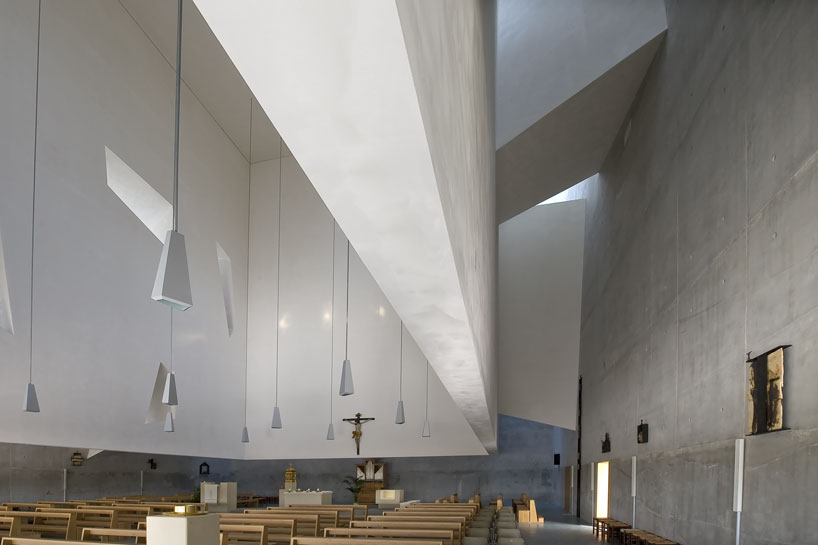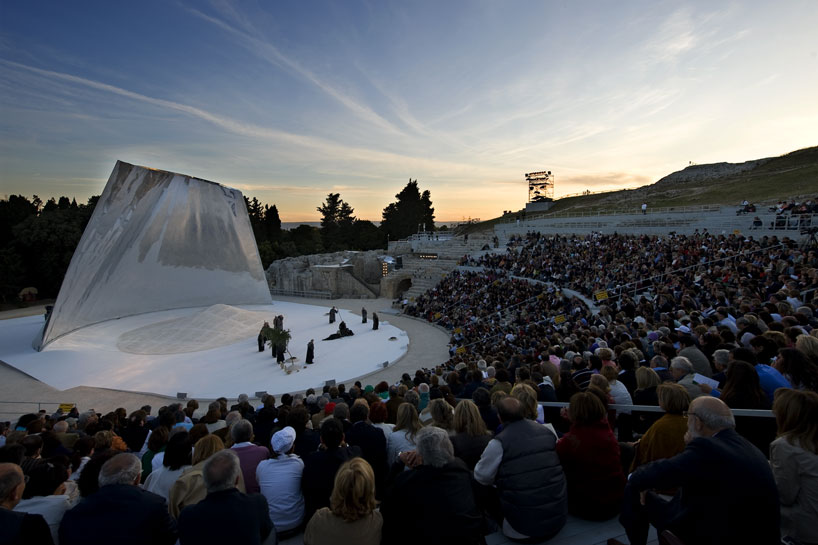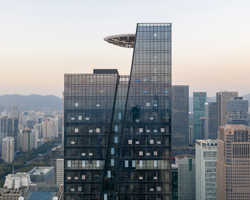doriana fuksas of fuksas architects portrait © designboom
— designboom met doriana fuksas at her studio in rome, italy on december 10th, 2010. —
what is the best moment of the day? the transition between night and day. because as the night is finishing, the day is starting again.
what kind of music do you listen to at the moment? at the moment I am listening to giovanni allevi, so contemporary classic. what books do you have on your bedside table? I have haruki murakami. I usually read japanese literature because I prefer reading about something I don’t know anything about, to experience different emotions, or try to understand other civilization… I also enjoy chinese and indian literature.
 palatino centre – shopping mall, turin, italy, 2011 image courtesy of massimiliano fuksas architetto photo by maruizio marcato
palatino centre – shopping mall, turin, italy, 2011 image courtesy of massimiliano fuksas architetto photo by maruizio marcato
 palatino centre – shopping mall, turin, italy, 2011 image courtesy of massimiliano fuksas architetto photo by moreni maggi
palatino centre – shopping mall, turin, italy, 2011 image courtesy of massimiliano fuksas architetto photo by moreni maggi
 palatino centre – shopping mall, turin, italy, 2011 image courtesy of massimiliano fuksas architetto photo by maruizio marcato
palatino centre – shopping mall, turin, italy, 2011 image courtesy of massimiliano fuksas architetto photo by maruizio marcato
 palatino centre – shopping mall, turin, italy, 2011 image courtesy of massimiliano fuksas architetto photo by ramon prat
palatino centre – shopping mall, turin, italy, 2011 image courtesy of massimiliano fuksas architetto photo by ramon prat
do you read design / architecture / fashion magazines? I don’t like them so much because I don’t think it’s useful to look at what other people are doing. it’s better to observe things that are not strictly connected with your world.
where do you get news from? everywhere – not from TV anymore. from the internet where you can find not only news of course, but images, you can connect with other people and real data…
 lyon confluence housing – lyon, france, 2005-2010 image courtesy of massimiliano fuksas architetto photo by philippe ruault
lyon confluence housing – lyon, france, 2005-2010 image courtesy of massimiliano fuksas architetto photo by philippe ruault
 lyon confluence housing – lyon, france, 2005-2010 image courtesy of massimiliano fuksas architetto photo by philippe ruault
lyon confluence housing – lyon, france, 2005-2010 image courtesy of massimiliano fuksas architetto photo by philippe ruault
 lyon confluence housing – lyon, france, 2005-2010 image courtesy of massimiliano fuksas architetto photo by philippe ruault
lyon confluence housing – lyon, france, 2005-2010 image courtesy of massimiliano fuksas architetto photo by philippe ruault
how do you approach fashion? what kind of clothes do you avoid wearing?
this is very difficult because maybe up until five, or even more than five years it was not difficult.
I am referring to the japanese again, but with issey miyake in the early 80s, after yohji yamamoto and comme des garçons…
the kind of innovation at that moment, I think it’s finished and it’s a pity.
now I think it’s more, in some ways vintage, because it’s things about the 60s that are nice again.
I do like balenciaga, even contemporaries like céline or lanvin.
comme des garçons is still nice, but the key is to put together different pieces –
how to take what you like and put it together.
is there anything you avoid wearing? certain colors or…?
I prefer black of course.
darker tones, but that doesn’t mean I don’t buy colors.
I do, they’re just not very easy to wear.
do you have any pets? yes, I have a small dog named ‘bear’.
 st. paolo church, foligno, italy, 2001-2009 image courtesy of massimiliano fuksas architetto photo by moreno maggi
st. paolo church, foligno, italy, 2001-2009 image courtesy of massimiliano fuksas architetto photo by moreno maggi
 st. paolo church, foligno, italy, 2001-2009 image courtesy of massimiliano fuksas architetto photo by moreno maggi
st. paolo church, foligno, italy, 2001-2009 image courtesy of massimiliano fuksas architetto photo by moreno maggi
 st. paolo church, foligno, italy, 2001-2009 image courtesy of massimiliano fuksas architetto photo by moreno maggi
st. paolo church, foligno, italy, 2001-2009 image courtesy of massimiliano fuksas architetto photo by moreno maggi
 st. paolo church, foligno, italy, 2001-2009 image courtesy of massimiliano fuksas architetto photo by moreno maggi
st. paolo church, foligno, italy, 2001-2009 image courtesy of massimiliano fuksas architetto photo by moreno maggi
 st. paolo church, foligno, italy, 2001-2009 image courtesy of massimiliano fuksas architetto photo by moreno maggi
st. paolo church, foligno, italy, 2001-2009 image courtesy of massimiliano fuksas architetto photo by moreno maggi
when you were a child, did you want to become a architect?
no.
in fact before studying and working in architecture I studied art history and was an art historian,
so I am still very much in love with more artists than architects.
where do you work on your designs and projects? everywhere. I don’t think it’s so important where you work. it is easier sometimes because you have what you need available such as paper etc. but having the ideas is the most important thing, and these you can have anywhere.
 set design for medea and edipo a colono, greek theatre, siracusa, italy, 2009 image courtesy of massimiliano fuksas architetto photo by moreno maggi
set design for medea and edipo a colono, greek theatre, siracusa, italy, 2009 image courtesy of massimiliano fuksas architetto photo by moreno maggi
 set design for medea and edipo a colono, greek theatre, siracusa, italy, 2009 image courtesy of massimiliano fuksas architetto photo by moreno maggi
set design for medea and edipo a colono, greek theatre, siracusa, italy, 2009 image courtesy of massimiliano fuksas architetto photo by moreno maggi
 set design for medea and edipo a colono, greek theatre, siracusa, italy, 2009 image courtesy of massimiliano fuksas architetto photo by moreno maggi
set design for medea and edipo a colono, greek theatre, siracusa, italy, 2009 image courtesy of massimiliano fuksas architetto photo by moreno maggi
do you discuss your work with other designers / architects outside of the studio?
no.
I discuss with my partner and husband massimiliano fuksas,
also outside of the studio, but it’s not because we want to speak about work.
it’s just normal – work is quite the life, and so professional and private merges together
and you can’t separate them so you just share the two worlds.
are there any design projects you are working on right now that you can speak about?
we have many.
we are doing big projects as well as small designed objects which makes the job more interesting
because going from working on a small jewel to an architectural structure is amazing,
but you still follow a similar process.
describe your style, like a good friend of yours would describe it. I try not to have a style. of course you can perhaps find two or three projects that are similar in their approach. for example, our houses, where we live, one can recognize that they’re of the same person, but also that they could be of two different owners, because our homes in rome and paris are not identical. there are some objects of similar designers, so there is a particular mood that is noticeable, but I couldn’t tell you what it is.
 admirant entrance building – mixed use, eindhoven, the netherlands, 2003-2010 image courtesy of massimiliano fuksas architetto photo by robert hart
admirant entrance building – mixed use, eindhoven, the netherlands, 2003-2010 image courtesy of massimiliano fuksas architetto photo by robert hart
 admirant entrance building – mixed use, eindhoven, the netherlands, 2003-2010 image courtesy of massimiliano fuksas architetto photo by moreno maggi
admirant entrance building – mixed use, eindhoven, the netherlands, 2003-2010 image courtesy of massimiliano fuksas architetto photo by moreno maggi
 18.septemberplein – bicycle cellar and urban square, eindhoven, the netherlands, 2003-2010 image courtesy of massimiliano fuksas architetto photo by robert hart
18.septemberplein – bicycle cellar and urban square, eindhoven, the netherlands, 2003-2010 image courtesy of massimiliano fuksas architetto photo by robert hart
 18.septemberplein – bicycle cellar and urban square, eindhoven, the netherlands, 2003-2010 image courtesy of massimiliano fuksas architetto photo by robert hart
18.septemberplein – bicycle cellar and urban square, eindhoven, the netherlands, 2003-2010 image courtesy of massimiliano fuksas architetto photo by robert hart
please describe an evolution in your work, from your first projects to the present day.
mmm…
I’d rather not!
of course the first projects were completed when we were much younger,
so maybe a little bit more, I have not the word in english…
‘ingenui’ (which means ‘naïve’ in italian).
what project has given you the most satisfaction?
the next one! (laughs)
I don’t know yet.
who would you like to design something for?
I don’t know, but you can find something good in every client.
the most important thing is that they must be clever because its better for flow of ideas.
 armani fifth avenue, new york city, USA, 2007-2009 image courtesy of massimiliano fuksas architetto photo by ramon prat
armani fifth avenue, new york city, USA, 2007-2009 image courtesy of massimiliano fuksas architetto photo by ramon prat
 armani fifth avenue, new york city, USA, 2007-2009 image courtesy of massimiliano fuksas architetto photo by ramon prat
armani fifth avenue, new york city, USA, 2007-2009 image courtesy of massimiliano fuksas architetto photo by ramon prat
 armani fifth avenue, new york city, USA, 2007-2009 image courtesy of massimiliano fuksas architetto photo by ramon prat
armani fifth avenue, new york city, USA, 2007-2009 image courtesy of massimiliano fuksas architetto photo by ramon prat
is there any designer and/or architect from the past, you appreciate a lot?
no, but there are artists that I like very much.
it’s not always about a particular form that influences me, but volumes, colors, atmosphere…
it is this that remains in your mind after you have seen it, much like in nature.
for example, when you visit a beautiful country or land, mountains, snow, water the image stays with you.
of course there is picasso. how can you not speak about him.
he was intelligent and clever in his ideas, always staying true to his style.
and those still working / contemporary?
antony gormley.
I am not sure, but many english sculptors and artists.
 colombina collection (dinner set) for alessi, 2007-2010 image courtesy of massimiliano fuksas architetto
colombina collection (dinner set) for alessi, 2007-2010 image courtesy of massimiliano fuksas architetto
 colombina collection (dinner set) for alessi, 2007-2010 image courtesy of massimiliano fuksas architetto
colombina collection (dinner set) for alessi, 2007-2010 image courtesy of massimiliano fuksas architetto
 colombina collection (dinner set) for alessi, 2007-2010 image courtesy of massimiliano fuksas architetto
colombina collection (dinner set) for alessi, 2007-2010 image courtesy of massimiliano fuksas architetto
 colombina collection (sugar and creamer) for alessi, 2007-2010 image courtesy of massimiliano fuksas architetto
colombina collection (sugar and creamer) for alessi, 2007-2010 image courtesy of massimiliano fuksas architetto
what advice would you give to the young?
to study.
it is difficult because many young people are attached to new media and technology which is good,
but when you are glued to these devices all day, always working the with internet, chatting etc.
there comes a point when you should just pick-up a book.
schools still have to find a way to communicate learning in another way, that you still have to study as we did,
like most people did until now. I think this is important. when you are so young you don’t understand
what will benefit you when you are older – even within five years of where you are at a particular moment.
do you teach yourself?
I tried it for one year, but I can’t and I don’t like it.
however in the office we do because we take in young people who have just finished university,
and we are engaged in this kind of teaching. it’s hard because when you have finished university,
you may be a bit better than when you started but it’s not enough. you have to once again,
work and learn a lot but in a new context, so I think this is interesting to do the ‘after university’ teaching
and educating in the studio / office environment.
what are you afraid of regarding the future?
a lot of things, but what I don’t know!
about everything or nothing.
anyways, we are living in this moment so we should let things go.
 zouhria vase for alessi, 2010 image courtesy of massimiliano fuksas architetto
zouhria vase for alessi, 2010 image courtesy of massimiliano fuksas architetto

carolina for poltrona frau, 2008 image courtesy of massimiliano fuksas architetto
doriana o. mandrelli was born in rome. she graduated in history of modern and contemporary architecture in 1979 at la sapienza university in rome, italy. she also graduated in architecture at l’École spéciale d’architecture (ESA) in paris, france. in 1985 she began cooperating with massimiliano fuksas and since 1997 she has been responsible for fuksas design. in 2000 for the ‘VII international architecture exhibition in venice’, ‘less aesthetics, more ethics’, she was the curator of four special sections: jean prouvé, jean maneval, the peace pavilion and architecture of spaces, and the art section. in 2002 she was decorated with ‘officier de l’ordre des arts et des lettres de la république française’. she was member of the executive board of INARCH (national institute of architecture). she has done didactic activities at the institute of history of art at the faculty of letters and arts and at industrial design department ITACA at la sapienza university. she works and lives in rome and in paris. http://www.fuksas.it






